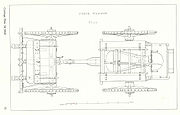
Traveling Forge
Encyclopedia




Confederate States Army
The Confederate States Army was the army of the Confederate States of America while the Confederacy existed during the American Civil War. On February 8, 1861, delegates from the seven Deep South states which had already declared their secession from the United States of America adopted the...
armies during the American Civil War
American Civil War
The American Civil War was a civil war fought in the United States of America. In response to the election of Abraham Lincoln as President of the United States, 11 southern slave states declared their secession from the United States and formed the Confederate States of America ; the other 25...
,
as well as by western European armies.
The traveling forge was frequently also referred to in The Official Records simply as a forge , and sometimes referred to by Civil War buffs as a battery forge.
An American Civil War-era traveling forge contained 1200 pounds (544.3 kg) of tools, coal and supplies. These tools and supplies included a bellows attached to a fireplace, a 4 inches (101.6 mm) vise, 100 pounds (45.4 kg) anvil, a box containing 250 pounds (113.4 kg) of coal, 200 pounds (90.7 kg) of horse shoes, 4 feet (1.2 m) bundled bars of iron, and on the limber was a box containing the smith's hand tools.
A battery wagon accompanied each traveling forge carrying additional blacksmith, wheelwright
Wheelwright
A wheelwright is a person who builds or repairs wheels. The word is the combination of "wheel" and the archaic word "wright", which comes from the Old English word "wryhta", meaning a worker or maker...
, and carriage repair supplies.
American Civil War-era traveling forge wagons evolved from crude blacksmith carts used during the American Revolutionary War
American Revolutionary War
The American Revolutionary War , the American War of Independence, or simply the Revolutionary War, began as a war between the Kingdom of Great Britain and thirteen British colonies in North America, and ended in a global war between several European great powers.The war was the result of the...
as well as from equipment used in Europe during the 1840s. British traveling forges were documented in An Aide-Memoire to the Military Sciences volume 1 by Royal Engineers, British Service, 1845, Col. G.G. Lewis, senior editor.
British traveling forges likely had canvas covers as indicated by the number and spacing of wood arches above the bellows, and what appears to be cord anchor points on the sides of the bellows house. A canvas cover would have been logical as protection of the bellows from the weather, and in accordance with the standard practice of covering wagons at that time. This canvas cover evolved into the wooden cover of the U.S. version of the traveling forge.
The U.S. mid-19th century traveling forge was standardized for U.S. manufacturers in the drawings created by Captain Albert Mordecai circa 1850 under commission by the federal government
Federal government
The federal government is the common government of a federation. The structure of federal governments varies from institution to institution. Based on a broad definition of a basic federal political system, there are two or more levels of government that exist within an established territory and...
. Copies of Captain Mordecai'a drawings are currently published by Antique Ordnance Publishers. The book Field Artillery Traveling Forge book No. 61 published by Antique Ordnance Publishers contains most of the measured drawings and other information necessary to reproduce the traveling forge. Additional crucial information covering measurements, construction and materials used with the traveling forge may be found in the Ordnance Manual of 1863.
The Ordnance Manual of 1863 says that in use, the traveling forge was hooked to the back of a limber that was identical in construction to the limbers used to pull field cannon
Cannon
A cannon is any piece of artillery that uses gunpowder or other usually explosive-based propellents to launch a projectile. Cannon vary in caliber, range, mobility, rate of fire, angle of fire, and firepower; different forms of cannon combine and balance these attributes in varying degrees,...
, except for the internal arrangement of the limber chest. The Ordnance Manual of 1863 details information about the wheels, paint, wood and iron parts used on the traveling forge, as well as the tools stored in the traveling forge's limber chest and in the battery wagon for use by the blacksmiths and artisans.
During the Civil War, a traveling forge was provided for each cannon battery, and other traveling forges accompanied each army to provide service to equipment and horses. Portable sheet metal
Sheet metal
Sheet metal is simply metal formed into thin and flat pieces. It is one of the fundamental forms used in metalworking, and can be cut and bent into a variety of different shapes. Countless everyday objects are constructed of the material...
Mountain Forges were provided to units with mountain howitzers which were primarily deployed in mountainous areas inaccessible to the No. 1 cannon carriage and wagons.

